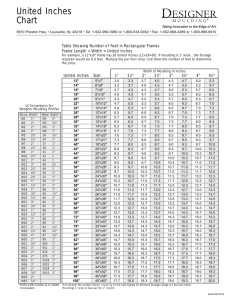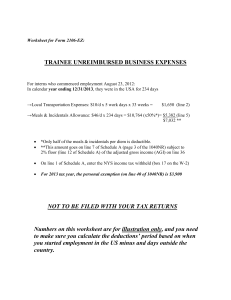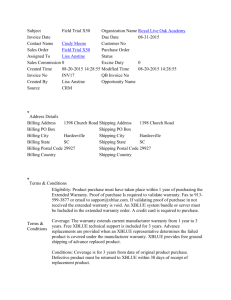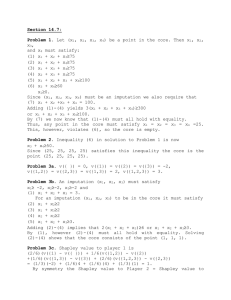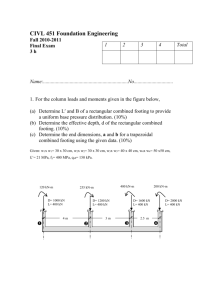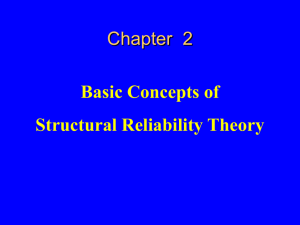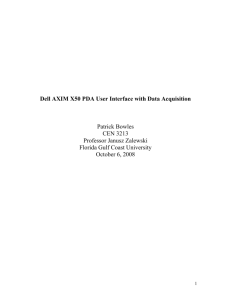65, 2 (2013), 204–212 June 2013 COMMON FIXED POINT RESULTS FOR NON-LINEAR G
advertisement
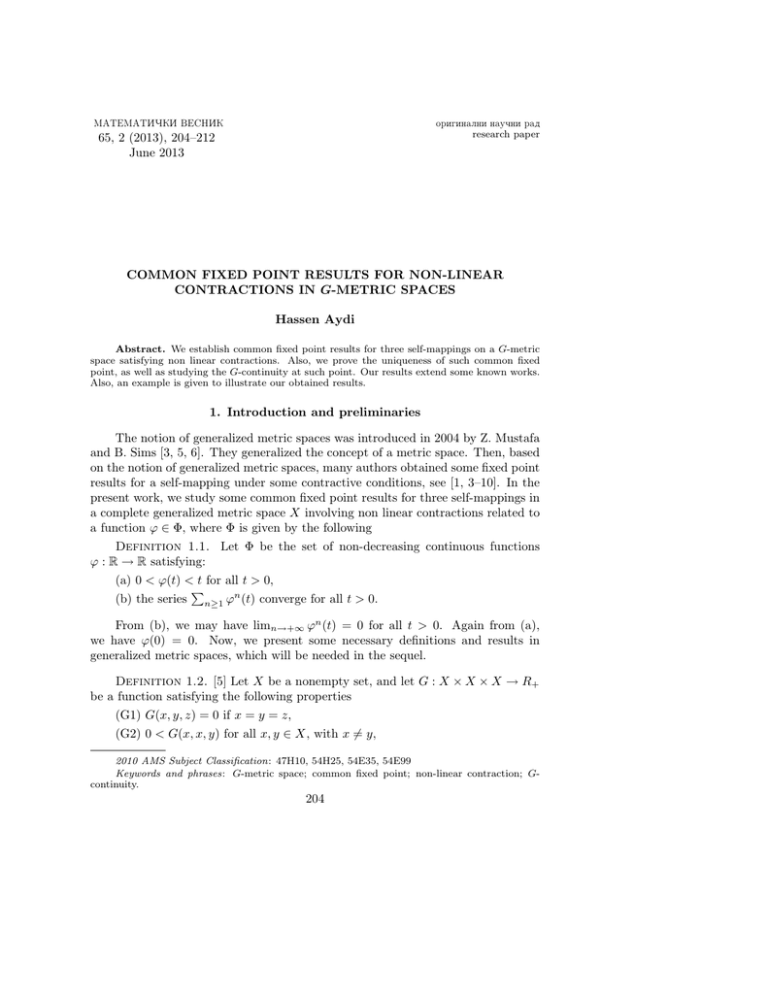
MATEMATIQKI VESNIK
originalni nauqni rad
research paper
65, 2 (2013), 204–212
June 2013
COMMON FIXED POINT RESULTS FOR NON-LINEAR
CONTRACTIONS IN G-METRIC SPACES
Hassen Aydi
Abstract. We establish common fixed point results for three self-mappings on a G-metric
space satisfying non linear contractions. Also, we prove the uniqueness of such common fixed
point, as well as studying the G-continuity at such point. Our results extend some known works.
Also, an example is given to illustrate our obtained results.
1. Introduction and preliminaries
The notion of generalized metric spaces was introduced in 2004 by Z. Mustafa
and B. Sims [3, 5, 6]. They generalized the concept of a metric space. Then, based
on the notion of generalized metric spaces, many authors obtained some fixed point
results for a self-mapping under some contractive conditions, see [1, 3–10]. In the
present work, we study some common fixed point results for three self-mappings in
a complete generalized metric space X involving non linear contractions related to
a function ϕ ∈ Φ, where Φ is given by the following
Definition 1.1. Let Φ be the set of non-decreasing continuous functions
ϕ : R → R satisfying:
(a) 0 < ϕ(t) < t for all t > 0,
P
(b) the series n≥1 ϕn (t) converge for all t > 0.
From (b), we may have limn→+∞ ϕn (t) = 0 for all t > 0. Again from (a),
we have ϕ(0) = 0. Now, we present some necessary definitions and results in
generalized metric spaces, which will be needed in the sequel.
Definition 1.2. [5] Let X be a nonempty set, and let G : X × X × X → R+
be a function satisfying the following properties
(G1) G(x, y, z) = 0 if x = y = z,
(G2) 0 < G(x, x, y) for all x, y ∈ X, with x 6= y,
2010 AMS Subject Classification: 47H10, 54H25, 54E35, 54E99
Keywords and phrases: G-metric space; common fixed point; non-linear contraction; Gcontinuity.
204
Common fixed point results in G-metric spaces
205
(G3) G(x, x, y) ≤ G(x, y, z) for all x, y, z ∈ X, with y 6= z
(G4) G(x, y, z) = G(x, z, y) = G(y, z, x) = · · · , (symmetry in all three variables),
(G5) G(x, y, z) ≤ G(x, , a, a) + G(a, y, z), for all x, y, z, a ∈ X, (rectangle inequality).
Then the function G is called a generalized metric, or, more specially, a Gmetric on X, and the pair (X, G) is called a G-metric space.
Definition 1.3. [5] Let (X, G) be a G-metric space and let (xn ) be a sequence
of points of X, a point x ∈ X is said to be the limit of the sequence (xn ), if
limn,m→+∞ G(x, xn , xm ) = 0, and we say that the sequence (xn ) is G-convergent
to x or (xn ) G-converges to x.
Thus, xn → x in a G-metric space (X, G) if for any ε > 0 there exists k ∈ N
such that G(x, xn , xm ) < ε for all m, n ≥ k.
Proposition 1.4. [5] Let (X, G) be a G-metric space. Then the following are
equivalent
(1) {xn } is is G-convergent to x;
(2) G(xn , xn , x) → 0 as n → +∞
(3) G(xn , x, x) → 0 as n → +∞
(4) G(xn , xm , x) → 0 as n, m → +∞.
Definition 1.5. [5] Let (X, G) be a G-metric space. A sequence {xn } is
is called a G-Cauchy sequence if for any ε > 0 there exists k ∈ N such that
G(xn , xm , xl ) < ε for all m, n, l ≥ k, that is G(xn , xm , xl ) → 0 as n, m, l → +∞.
Proposition 1.6. [6] Let (X, G) be a G-metric space. Then the following are
equivalent:
(1) the sequence {xn } is G-Cauchy;
(2) for any ε > 0 there exists k ∈ N such that G(xn , xm , xm ) < ε for all
m, n ≥ k.
Proposition 1.7. [5] Let (X, G) be a G-metric space. Then, f : X → X is
G-continuous at x ∈ X if and only if it is G-sequentially continuous at x, that is,
whenever (xn ) is G-convergent to x, (f (xn )) is G-convergent to f (x).
Proposition 1.8. [5] Let (X, G) be a G-metric space. Then, the function
G(x, y, z) is jointly continuous in all three of its variables.
Proposition 1.9. [5] A G-metric space (X, G) is called G-complete if every
G-Cauchy sequence is G-convergent in (X, G).
Every G-metric on X will define a metric dG on X by
dG (x, y) = G(x, y, y) + G(y, x, x), for all x, y ∈ X.
(1.1)
206
H. Aydi
In this paper, we address the question to find some common fixed point results
on G-metric spaces. More precisely, taking three self-mappings on a complete Gmetric space satisfying non-linear contractions, we establish a common fixed point
result. Also, some corollaries and an example are given.
2. Main results
Our first main result is the following
Theorem 2.1. Let (X, G) be a complete G-metric space. Suppose the maps
T1 , T2 , T3 : X → X satisfy for all x, y, z ∈ X
G(T1 x, T2 y, T3 z) ≤ ϕ(M (x, y, z)),
(2.1)
where
M (x, y, z) =: max{G(x, y, z), G(x, T1 x, T1 x), G(y, T2 y, T2 y), G(z, T3 z, T3 z)},
and ϕ ∈ Φ. Then T1 , T2 and T3 have a unique common fixed point, say u. Moreover,
each Ti , i = 1, 2, 3, is continuous at u.
Proof. Let x0 be an arbitrary point in X. Take x1 = T1 x0 , x2 = T2 x1 and
x3 = T3 x2 . Then, we can construct a sequence {xn } in X such that for any n ∈ N
x3n+1 = T1 x3n
x3n+2 = T2 x3n+1
(2.2)
x3n+3 = T3 x3n+2 .
• If there exists p ∈ N∗ such that x3p = x3p+1 = x3p+2 , then applying the
contractive condition (2.1) with x = x3p , y = x3p+1 and z = x3p+2 , we get
G(x3p+1 , x3p+2 , x3p+3 ) =: G(T1 x3p , T2 x3p+1 , T3 x3p+2 )
≤ ϕ(max{G(x3p , x3p+1 , x3p+2 ), G(x3p , T1 x3p , T1 x3p ),
G(x3p+1 , T2 x3p+1 , T2 x3p+1 ), G(x3p+2 , T3 x3p+2 , T3 x3p+2 )})
= ϕ(max{G(x3p , x3p+1 , x3p+2 ), G(x3p , x3p+1 , x3p+1 ),
G(x3p+1 , x3p+2 , x3p+2 ), G(x3p+2 , x3p+3 , x3p+3 )})
= ϕ(G(x3p+2 , x3p+3 , x3p+3 )).
(2.3)
If x3p+3 6= x3p+1 , then from the conditions (G3), (G4) and the property (a) of ϕ,
we get
0 < G(x3p+1 , x3p+2 , x3p+3 ) ≤ ϕ(G(x3p+1 , x3p+2 , x3p+3 )) < G(x3p+1 , x3p+2 , x3p+3 ),
that is a contradiction. So we find xn = x3p for any n ≥ 3p. This implies that (xn )
is a G-cauchy sequence. The same conclusion holds if x3p+1 = x3p+2 = x3p+3 , or
x3p+2 = x3p+3 = x3p+4 for some p ∈ N.
• Assume for the rest that xn 6= xm for any n 6= m. Applying again (2.1) with
x = x3n , y = x3n+1 and z = x3n+2 and using the condition (G3), we get that
G(x3n+1 , x3n+2 , x3n+3 ) ≤ ϕ(max{G(x3n , x3n+1 , x3n+2 ), G(x3n , x3n+1 , x3n+1 ),
207
Common fixed point results in G-metric spaces
G(x3n+1 , x3n+2 , x3n+2 ), G(x3n+2 , x3n+3 , x3n+3 )})
= ϕ(max{G(x3n , x3n+1 , x3n+2 ), G(x3n+1 , x3n+2 , x3n+3 )}).
(2.4)
The case where
max{G(x3n , x3n+1 , x3n+2 ), G(x3n+1 , x3n+2 , x3n+3 )} = G(x3n+1 , x3n+2 , x3n+3 )
is excluded, because if it holds we have from (2.4)
0 < G(x3n+1 , x3n+2 , x3n+3 ) ≤ ϕ(G(x3n+1 , x3n+2 , x3n+3 ))
< G(x3n+1 , x3n+2 , x3n+3 ),
which is a contradiction. Thus, we deduce
max{G(x3n , x3n+1 , x3n+2 ), G(x3n+1 , x3n+2 , x3n+3 )} = G(x3n , x3n+1 , x3n+2 ).
Therefore, (2.4) gives us
G(x3n+1 , x3n+2 , x3n+3 ) ≤ ϕ(G(x3n , x3n+1 , x3n+2 )) < G(x3n , x3n+1 , x3n+2 ). (2.5)
Similarly
G(x3n+2 , x3n+3 , x3n+4 ) < G(x3n+1 , x3n+2 , x3n+3 ),
G(x3n+3 , x3n+4 , x3n+5 ) < G(x3n+2 , x3n+3 , x3n+4 ).
From the above three inequalities, one can assert that
G(xn , xn+1 , xn+2 ) < G(xn−1 , xn , xn+1 ) ∀ n ∈ N∗ .
(2.6)
If we take tn = G(xn , xn+1 , xn+2 ), then 0 ≤ tn ≤ tn−1 , so the real sequence (tn )
is decreasing, hence it converges to some r ≥ 0. Assume that r > 0, then letting
n → +∞ in (2.5),
r ≤ ϕ(r) < r,
using the properties of ϕ. It is a contradiction, so we have r = 0. Thus
lim G(xn , xn+1 , xn+2 ) = 0.
n→+∞
(2.7)
Next, we prove that (xn ) is a G-Cauchy sequence. Following (2.5) and (2.6), one
can write
G(xn , xn+1 , xn+2 ) ≤ ϕ(G(xn−1 , xn , xn+1 )).
(2.8)
Consequently,
G(xn , xn+1 , xn+2 ) ≤ ϕn (G(x0 , x1 , x2 )).
(2.9)
Therefore, using conditions (G3), (G4), (G5) and (2.9), we have for any k ∈ N
G(xn , xn+k , xn+k )
≤ G(xn , xn+1 , xn+1 ) + G(xn+1 , xn+2 , xn+2 ) + G(xn+2 , xn+3 , xn+3 )
+ · · · + G(xn+k−2 , xn+k−1 , xn+k−1 ) + G(xn+k−1 , xn+k , xn+k )
208
H. Aydi
≤ G(xn , xn+1 , xn+2 ) + G(xn+1 , xn+2 , xn+3 ) + G(xn+2 , xn+3 , xn+4 )
+ · · · + G(xn+k−2 , xn+k−1 , xn+k ) + G(xn+k−1 , xn+k , xn+k+1 )
≤ ϕn (G(x0 , x1 , x2 )) + ϕn+1 (G(x0 , x1 , x2 )) + ϕn+2 (G(x0 , x1 , x2 ))
+ · · · + ϕn+k (G(x0 , x1 , x2 ))
=
n+k
P
i=n
ϕi (G(x0 , x1 , x2 )) ≤
+∞
P
i=n
ϕi (G(x0 , x1 , x2 )).
P+∞
The property (b) yields that i=n ϕi (G(x0 , x1 , x2 )) tends to 0 as n → +∞. Therefore
lim G(xn , xn+k , xn+k ) = 0 ∀ k ∈ N.
n→+∞
This means that (xn ) is a G-Cauchy sequence and since (X, G) is G-complete, (xn )
is G-convergent to some u ∈ X, that is
lim G(xn , xn , u) = lim G(xn , u, u) = 0.
n→+∞
n→+∞
(2.10)
Now, we show that u is a common fixed point of the maps Ti , i = 1, 2, 3. We start
by proving the case T1 u = u. From (2.1), we get that
G(u, u, T1 u)
≤ G(u, u, x3n+1 ) + G(x3n+1 , x3n+1 , T1 u)
= G(u, u, x3n+1 ) + G(T1 x3n , T1 x3n , T1 u)
≤ G(u, u, x3n+1 ) + ϕ(M (x3n , x3n , u)),
(here T3 = T2 = T1 )
= G(u, u, x3n+1 ) + ϕ(max{G(x3n , x3n , u), G(x3n , T1 x3n , T1 x3n , G(u, u, T1 u)})
= G(u, u, x3n+1 ) + ϕ(max{G(x3n , x3n , u), G(x3n , x3n+1 , x3n+1 ), G(u, u, T1 u)}).
(2.11)
Using (2.10), the continuity of ϕ and letting n → +∞ in (2.11), we get that
G(u, u, T1 u) ≤ ϕ(G(u, u, T1 u)). Assume that T1 u 6= u; hence the condition (G2)
implies that G(u, u, T1 u) > 0, so
G(u, u, T1 u) ≤ ϕ(G(u, u, T1 u)) < G(u, u, T1 u),
which is a contradiction, so T1 u = u. By symmetry, we can find that T2 u = u = T3 u,
so u is a common fixed point of the three maps T1 , T2 and T3 . Let v be another
fixed point of each Ti , i = 1, 2, 3. By (2.1)
G(u, u, v) = G(T1 u, T2 u, T3 v)
≤ ϕ(max{G(u, u, v), G(u, T1 u, T1 u), G(u, T2 u, T2 u), G(v, T3 v, T3 v)})
= ϕ(max{G(u, u, v), G(u, u, u), G(v, v, v)})
= ϕ(G(u, u, v)),
which is true unless G(u, u, v) = 0. This yields that u = v. Let us show that
each Ti , i = 1, 2, 3, is G-continuous at u. By symmetry again, it suffices to prove
Common fixed point results in G-metric spaces
209
the G-continuity of one of them, for example for T1 . For this, let (un ) ⊆ X be a
sequence such that (un ) G-converges to u. First, we have
G(u, , T1 un , T1 un ) = G(T1 u, T1 un , T1 un )
≤ ϕ(max{G(u, un , un ), G(u, u, u), G(un , T1 un , T1 un )})
= ϕ(max{G(u, un , un ), G(un , T1 un , T1 un )})
≤ ϕ(G(u, un , un ) + G(un , T1 un , T1 un ))
≤ ϕ(G(u, un , un ) + G(un , u, u) + G(u, T1 un , T1 un )).
Say limn→+∞ G(u, T1 un , T1 un ) = s, then if s > 0, using (2.10) and the continuity
of ϕ and letting n → +∞ in the above inequality we have
s ≤ ϕ(s) < s;
it is a contradiction, hence s = 0. On the other hand, we have
G(u, , u, T1 un ) = G(T1 u, T1 u, T1 un )
≤ ϕ(max{G(u, u, un ), G(u, u, u), G(u, u, u), G(un , T1 un , T1 un )})
= ϕ(max{G(u, u, un ), G(un , T1 un , T1 un )})
≤ ϕ(max{G(u, u, un ), G(un , u, u) + G(u, T1 un , T1 un )})
= ϕ(G(un , u, u) + G(u, T1 un , T1 un )).
Take limn→+∞ G(u, u, T1 un ) = t; then letting n → +∞ and using s = 0 and the
continuity of ϕ, we get that
t ≤ ϕ(0) = 0,
that is t = 0. We rewrite this as
lim G(u, u, T1 un ) =: lim G(T1 u, T1 u, T1 un ) = 0.
n→+∞
n→+∞
This means that the sequence (T1 un ) G-converges to u = T1 u, so T1 is G-continuous
at u. By symmetry, we deduce that each Ti , i = 1, 2, 3, is G-continuous at u.
Now, we give some corollaries of Theorem 2.1. The first corresponds to ϕ(t) =
kt where 0 ≤ k < 1.
Corollary 2.2. Let X be a complete G-metric space. Suppose the maps
T1 , T2 , T3 : X → X satisfy
G(T1 x, T2 y, T3 z) ≤ k max{G(x, y, z), G(x, T1 x, T1 x), G(y, T2 y, T2 y), G(z, T3 z, T3 z)},
(2.12)
for all x, y, z ∈ X, where 0 ≤ k < 1. Then, the mappings Ti , i = 1, 2, 3 have a
unique common fixed point, say u, and each Ti is G-continuous at u.
Corollary 2.3. Let X be a complete G-metric space. Suppose the maps
T1 , T2 , T3 : X → X satisfy
G(T1m x, T2m y, T3m z) ≤ ϕ(M (x, y, z)),
210
H. Aydi
for all x, y, z ∈ X and m ∈ N, where
M (x, y, z) =: max{G(x, y, z), G(x, T1m x, T1m x), G(y, T2m y, T2m y), G(z, T3m z, T3m z)},
and ϕ ∈ Φ. Then T1m , T2m and T3m have a unique common fixed point, say u, and
are G-continuous at u.
Proof. From Theorem 2.1, we conclude that the maps T1m , T2m and T3m have
a unique common fixed point say u. For any i = 1, 2, 3
Ti u = Ti (Tim u) = Tim+1 u = Tim (Ti u),
meaning that Ti u is also a fixed point of Tim . By uniqueness of u, we get Ti u = u.
We have again a common fixed point result for Hardy and Rogers’s contraction
type [2]. It is a consequence of Corollary 2.2 with k = a + b + c + d.
Corollary 2.4. Let X be a complete G-metric space. Suppose the maps
T1 , T2 , T3 : X → X satisfy
G(T1 x, T2 y, T3 z) ≤ aG(x, y, z)+bG(x, T1 x, T1 x)+cG(y, T2 y, T2 y)+dG(z, T3 z, T3 z),
for all x, y, z ∈ X, where a, b, c, d are non-negative reals such that a + b + c + d < 1.
Then T1 , T2 and T3 have a unique common fixed point, say u, and are G-continuous
at u.
Our Theorem 2.1 is again an extension of some recent new results by taking
particular cases of ϕ or T = T1 = T2 = T3 in 2.1 or in the above corollaries. We
cite them in the following corollaries.
Corollary 2.5. [4] Let X be a complete G-metric space. Suppose the map
T : X −→ X satisfies
G(T x, T y, T z) ≤ k max{G(x, y, z), G(x, T x, T x), G(y, T y, T y), G(z, T z, T z)},
for all x, y, z ∈ X, where 0 ≤ k < 1. Then, T has a unique fixed point, say u, and
T is G-continuous at u.
Corollary 2.6. [4] Let X be a complete G-metric space. Suppose the map
T : X → X satisfies for all x, y, z ∈ X
G(T x, T y, T z) ≤ aG(x, y, z) + bG(x, T x, T x) + cG(y, T y, T y) + dG(z, T z, T z),
where a, b, c, d are non-negative reals and a + b + c + d < 1. Then T has a unique
fixed point, say u, and T is G-continuous at u.
Corollary 2.7. [4] Let X be a complete G-metric space. Suppose the map
T : X → X satisfies for m ∈ N and x, y, z ∈ X
G(T m x, T m y, T m z) ≤ aG(x, y, z) + bG(x, T m x, T m x)
+ cG(y, T m y, T m y) + dG(z, T m z, T m z),
211
Common fixed point results in G-metric spaces
where a, b, c, d are non-negative reals and a + b + c + d < 1. Then T m has a unique
fixed point, say u, and is G-continuous at u.
We give an example illustrating our obtained results.
Example 2.8 Let X = [0, +∞) be endowed with the complete G-metric given
as follows:
G(x, y, z) = max{|x − y|, |x − z|, |y − z|},
for all x, y, z ∈ X. Define T1 , T2 , T3 : X → X by
T1 t =
t
,
2
T2 t = T3 t =
t
4
∀ t ≥ 0.
Take k = 14 . Without loss of generality, we assume that x ≤ y ≤ z, so
G(x, y, z) = max{|x − y|, |x − z|, |y − z|} = z − x,
y
z
x
G(x, T1 x, T1 x) = , G(y, T2 y, T2 y) = 3
and G(z, T3 z, T3 z) = 3 .
2
4
4
From these identities, the right-hand side of (2.12), denoted Rx,y,z , is equal to
Rx,y,z =
1
x 3y 3z
1
3z
max{z − x, , , } = max{z − x, }.
4
2 4 4
4
4
(2.13)
While, the left-hand side of (2.12) is
G(T1 x, T2 y, T3 z) = max{|
x y x z y z
− |, | − |, | − |}.
2
4 2
4 4 4
We distinguish the following cases:
• If
x
2
≤ y4 . From (2.14), we have G(T1 x, T2 y, T3 z) =
Case 1. If
z
4
z
4
z
x
1
− ≤ (z − x) = Rx,y,z .
4
2
4
≤ x. Here, we have from (2.13), Rx,y,z =
G(T1 x, T2 y, T3 z) =
• If
x
2
z
4
z
4
Then,
z
4
− y4 .
≥ x. By (2.13), we have Rx,y,z = 41 (z − x), so
G(T1 x, T2 y, T3 z) =
Case 2. If
3
16 z.
z
x
3
− ≤
z = Rx,y,z .
4
2
16
≥ y4 . By (2.14), we have G(T1 x, T2 y, T3 z) =
Case 1. If
− x2 .
≥ x. Here, we have from (2.13), Rx,y,z = 14 (z − x). Then,
G(T1 x, T2 y, T3 z) =
Case 2. If
z
4
z
y
1
− ≤ (z − x) = Rx,y,z .
4 4
4
≤ x. From (2.13), we have Rx,y,z =
G(T1 x, T2 y, T3 z) =
3
16 z,
so
y
3
z
− ≤
z = Rx,y,z .
4 4
16
(2.14)
212
H. Aydi
Note that in all cases, the inequality (2.12) holds for all x, y, z ∈ X. The hypotheses
of Corollary 2.2 satisfied, and 0 is the unique common fixed point of the mappings
T1 , T2 and T3 .
Acknowledgement. The author thanks the referees for their valuable comments.
REFERENCES
[1] H. Aydi, B. Damjanović, B. Samet, W. Shatanawi, Coupled fixed point theorems for nonlinear
contractions in partially ordered G-metric spaces, Math. Comput. Modelling 54 (2011), 2443–
2450.
[2] G.E. Hardy, T.D. Rogers, A generalization of a fixed point theorem of Reich, Canad. Math.
Bull. 16 (1973), 201-206.
[3] Z. Mustafa, A new structure for generalized metric spaces with applications to fixed point
theory, Ph.D. thesis, The University of Newcastle, Callaghan, Australia, (2005).
[4] Z. Mustafa, H. Obiedat, F. Awawdeh, Some fixed point theorem for mapping on complete
Gmetric spaces, Fixed Point Theory Appl. Vol. 2008, Article ID 189870, 12 pages (2008).
[5] Z. Mustafa, B. Sims, A new approach to generalized metric spaces, J. Nonlinear Convex
Anal. 7 (2006), 289-297.
[6] Z. Mustafa, B. Sims, Some remarks concerning D-metric spaces, in: Proc. Intern. Conf.
Fixed Point Theory Appl. (2004), 189-198, Yokohama, Japan.
[7] Z. Mustafa, B. Sims, Fixed point theorems for contractive mappings in complete G-metric
spaces, Fixed Point Theory Appl. Vol. 2009, Article ID 917175, 10 pages (2009).
[8] Z. Mustafa, W. Shatanawi, M. Bataineh, Existence of fixed point results in G-metric spaces,
Inter. J. Math. Math. Sci. Vol. 2009, Article ID 283028, 10 pages (2009).
[9] W. Shatanawi, Fixed point theory for contractive mappings satisfying Φ-maps in G-metric
spaces, Fixed Point Theory Appl. Vol. 2010, Article ID 181650, 9 pages (2010).
[10] W. Shatanawi, Some fixed point theorems in ordered G-metric spaces and applications, Abstract Appl. Anal. Vol. 2011, Article ID 126205, 11 pages (2011).
(received 21.06.2011; in revised form 31.10.2011; available online 01.01.2012)
Université de Sousse, Institut Supérieur d’Informatique et des Technologies de Communication de
Hammam Sousse, Route GP1-4011, H. Sousse, Tunisie
E-mail: hassen.aydi@isima.rnu.tn
